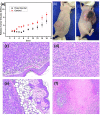Synergistic effect of sunlight induced photothermal conversion and H2O2 release based on hybridized tungsten oxide gel for cancer inhibition
- PMID: 27775086
- PMCID: PMC5075885
- DOI: 10.1038/srep35876
Synergistic effect of sunlight induced photothermal conversion and H2O2 release based on hybridized tungsten oxide gel for cancer inhibition
Abstract
A highly efficient photochromic hydrogel was successfully fabricated via casting precursor, which is based on amorphous tungsten oxide and poly (ethylene oxide)-block-poly (propylene oxide)-block-poly (ethylene oxide). Under simulated solar illumination, the hydrogel has a rapid and controlled temperature increasing ratio as its coloration degree. Localized electrons in the amorphous tungsten oxide play a vital role in absorption over a broad range of wavelengths from 400 nm to 1100 nm, encompassing the entire visible light and infrared regions in the solar spectrum. More importantly, the material exhibits sustainable released H2O2 induced by localized electrons, which has a synergistic effect with the rapid surface temperature increase. The amount of H2O2 released by each film can be tuned by the light irradiation, and the film coloration can indicate the degree of oxidative stress. The ability of the H2O2-releasing gels in vitro study was investigated to induce apoptosis in melanoma tumor cells and NIH 3T3 fibroblasts. The in vivo experimental results indicate that these gels have a greater healing effect than the control in the early stages of tumor formation.
Figures







Similar articles
-
An injectable thermosensitive photothermal-network hydrogel for near-infrared-triggered drug delivery and synergistic photothermal-chemotherapy.Acta Biomater. 2019 Sep 15;96:281-294. doi: 10.1016/j.actbio.2019.07.024. Epub 2019 Jul 15. Acta Biomater. 2019. PMID: 31319202
-
Injectable in Situ Forming Hydrogels of Thermosensitive Polypyrrole Nanoplatforms for Precisely Synergistic Photothermo-Chemotherapy.ACS Appl Mater Interfaces. 2020 Feb 19;12(7):7995-8005. doi: 10.1021/acsami.9b22654. Epub 2020 Feb 10. ACS Appl Mater Interfaces. 2020. PMID: 32013384
-
A NIR-II light-modulated injectable self-healing hydrogel for synergistic photothermal/chemodynamic/chemo-therapy of melanoma and wound healing promotion.J Mater Chem B. 2022 Oct 5;10(38):7717-7731. doi: 10.1039/d2tb00923d. J Mater Chem B. 2022. PMID: 35920389
-
A NIR-II light responsive hydrogel based on 2D engineered tungsten nitride nanosheets for multimode chemo/photothermal therapy.Chem Commun (Camb). 2019 Aug 7;55(64):9471-9474. doi: 10.1039/c9cc04132j. Chem Commun (Camb). 2019. PMID: 31328205
-
Overcoming chemotherapy resistance using pH-sensitive hollow MnO2 nanoshells that target the hypoxic tumor microenvironment of metastasized oral squamous cell carcinoma.J Nanobiotechnology. 2021 May 26;19(1):157. doi: 10.1186/s12951-021-00901-9. J Nanobiotechnology. 2021. PMID: 34039370 Free PMC article.
Cited by
-
Light-Responsive Inorganic Biomaterials for Biomedical Applications.Adv Sci (Weinh). 2020 Jul 17;7(17):2000863. doi: 10.1002/advs.202000863. eCollection 2020 Sep. Adv Sci (Weinh). 2020. PMID: 32995121 Free PMC article. Review.
-
Recent progress in topical and transdermal approaches for melanoma treatment.Drug Deliv Transl Res. 2025 May;15(5):1457-1495. doi: 10.1007/s13346-024-01738-z. Epub 2024 Dec 9. Drug Deliv Transl Res. 2025. PMID: 39653958 Review.
References
-
- Yamazaki S., Ishida H., Shimizu D. & Adachi K. Photochromic Properties of Tungsten Oxide/Methylcellulose Composite Film Containing Dispersing Agents. ACS Appl. Mater. Interfaces 7, 26326–26332 (2016). - PubMed
-
- Zhou X., Liu G., Yu J. & Fan W. Surface Plasmon Resonance-Mediated Photocatalysis by Noble Metal-based Composites under Visible Light. J. Mate. Chem. 22, 21337–21354 (2012).
-
- Lin W. Introduction: Nanoparticles in Medicine, Chem. Rev. 115, 10407–10409 (2015). - PubMed
Publication types
MeSH terms
Substances
LinkOut - more resources
Full Text Sources
Other Literature Sources
Medical

